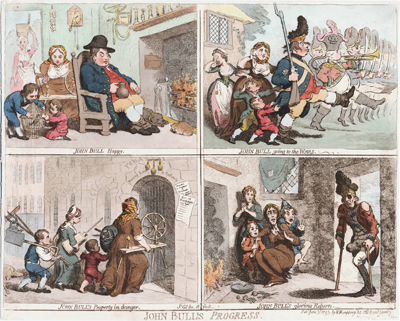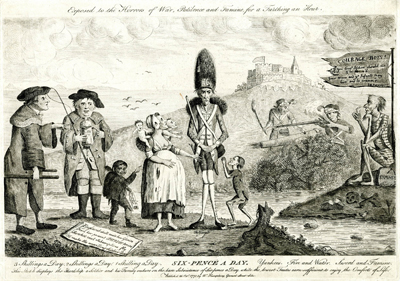John Bull's Progress
This four-panel "progress" shows the disastrous effects upon John Bull and his family resulting from his decision to join the army after the French declaration of war against Britain in February, 1793.

© Lewis Walpole Library, Yale University
It represents a break from Gillray's typical practice and the first time he used the multi-panel format to tell a consecutive story. Gillray had begun using multi-panel prints as early as 1782 with Minister In. Minister Out. But in that print, Gillray was drawing a simple contrast between two states or situations as he did later in France Freedom. Britain Slavery (1789) and The National Assembly Petrified. The National Assembly Revivified (1791). And when he used a four-panel format for Vices Overlook'd in the New Proclamation (1792), he used it to portray four discrete vices practiced by members of the royal family. There was nothing suggesting a "progress."
But of course there are at least two important predecessors for Gillray's Progress. The first is John Bunyan's Pilgrim's Progress (1678), the allegory of a young Christian's journey from the City of Destruction (after many misadventures) to the heavenly Celestial City. Having been early educated at a strict Moravian boarding school, Gillray would have known the book ever since he was a child. And he would have remembered the way the hero's encounters were both concrete yet representative, realistic in their attention to details and yet expressive of a general meaning. And indeed earlier in the same year as John Bull's Progress, Gillray had specifically alluded to one of the more famous of those encounters in his print, The Slough of Despond (Jan. 2, 1793).
The other major context for Gillray's Progress is the series of engravings by William Hogarth: A Harlot's Progress (1731) and A Rake's Progress (1733-35). Like Pilgrim's Progress, both Hogarth stories are essentially episodic with each plate devoted to a specific episode. But in Hogarth's series, the "progress" is completely ironic, for each plate takes the protagonist further down the path of destruction.
Like Bunyan and Hogarth, Gillray shows a series of moments or episodes in the life of central figure both individualized and yet representative. He begins with a rare idyllic moment showing the prototypical Englishman, John Bull, in his comfortable country cottage, dozing before the hearth holding his pitcher of small beer, surrounded by his family and domestic animals—all living together harmoniously. His wife is busy spinning, his daughter is just returning from the barnyard outside with a milk pail atop her head. And his two sons play with a pet bird.
In the second panel, John has joined the recruits and is marching off to a significantly undefined location beyond the frame. As in A March to the Bank (1787), joining the military seems to be associated in Gillray's mind with being swept up in a mindless mechanism, superficially orderly, but completely indifferent to human feeling.
In the third panel we see the practical result of his enlistment on John's family. Salaries for the common soldier were pathetically low. So now, in order to pay the British treasury the increased taxes of war time, John Bull's family is forced to pawn their few remaining possessions—even those possessions that could help them earn a living. It's no accident that the doorway to the pawnshop/treasury (with notices ironically calling for recruits and listing bankruptcies at the same time) seems to lead to the destitution of the final panel.
In the ironically titled fourth panel, "John Bull's Glorious Return," the emaciated John, with only one eye and one leg, returns to his starving family, who are understandably shocked by his appearance. They have been reduced to shoeless, starving penury, in a narrow room where everything is as broken as they are.
Gillray was the son of a war veteran who lost an arm at Fontenoy during the war of the Austrian Succession. Still living in 1794 at home with his parents, Gillray was reminded every day of the costs of war. One of his very first prints Six-Pence a Day was, like this one, a graphic argument against enlistment. But in contrasting the naturalistic scenes and clear sense of sequence in John Bull's Progress with the stiff, flat figures arranged unnaturally across the picture space, and the almost medieval obliteration of time and sequence in Six Pence a Day one can see how far Gillray and graphic caricature in general have moved from emblem to expression.

© Trustees of the British Museum
Sources and Reading
- Commentary from the British Museum on John Bull's Progress
- Draper Hill, Mr. Gillray The Caricaturist, 1965, p 46n
- Draper Hill, The Satirical Etchings of James Gillray, 1976, #31
- "John Bull," Wikipedia
- Thomas Wright and R.H. Evans, Historical and Descriptive Account of the Caricatures of James Gillray, #103
Comments & Corrections
NOTE: Comments and/or corrections are always appreciated. To make that easier, I have included a form below that you can use. I promise never to share any of the info provided without your express permission.